In this guide, I compare the Arctic vs Antarctica based on my travel experience with both regions. It offers a detailed overview of the two destinations to help you plan your travels. It covers:
- A comparison between the Arctic and Antarctica to help you plan your trip
- When to visit and seasonal differences
- The different wildlife you can see in the Arctic and Antarctic regions
- How the temperature and weather differ in each polar region
- Historical and geographical differences.
- Similarities between each region
Let’s explore!

Table Of Contents
If you haven’t visited the polar regions before, the Arctic and Antarctica appear similar on the surface. They are both polar climates characterised by uninhabited landscapes, sea ice and glaciers, and some of the most scenic places on Earth.
As we dig deeper, we will find out that while there are similarities (which I share at the end of the article), there are also many differences to consider when planning your visit. This guide will give you a detailed comparison of the Arctic and the Antarctic to help you plan your travels.
Warning! Travelling to the polar regions is highly addictive. Many travellers to Antarctica often return to visit different places in the Arctic.
Let’s start with the differences between the Arctic and Antarctica:
Antarctic Vs Arctic: 12 Key Differences
- Antarctica is a landmass in the southern hemisphere covered by a thick ice sheet up to 4km deep and is surrounded in all directions by the turbulent Southern Ocean (considered the roughest in the world). The Arctic is an ocean frozen year-round at its centre and surrounded by landmasses.
- Antarctica is a continent but not a country (it is the world’s only uninhabited and least visited continent). The Arctic is a region with eight countries within the Arctic Circle.
- The Arctic and Antarctica have opposite seasons. When it is summer in the Arctic, it is winter in Antarctica and vice versa.
- The Arctic is slightly larger than Antarctica due to the movement of the polar circles, which are not fixed. The Arctic has an area of 5.5 million square miles (14.5 million square km), which is approximately 4% of the world’s surface and is slightly smaller than Africa. Antarctica follows up a close second at 5.4 million square miles (14.2 million square km)
- Antarctica has more ice than the Arctic. The Antarctic ice sheet, with an area of 14 million km² and an average depth of 2km, covers 98% of Antarctica’s landmass. The largest ice sheet in the Arctic is the Greenland ice sheet, at 1.7 million km².
- Antarctica is significantly cooler than the Arctic, with cold temperatures due to its ice cap and elevation. The average summer temperature at the North Pole is 0° C (32° F) compared to −28.2° C (−18° F ) at the South Pole.
- Antarctica is higher than the Arctic. Mount Vinson is the tallest point in Antarctica, at 4,892 metres above sea level. The tallest mountain above the Arctic Circle is Gunnbjørn Fjeld, at 3,694 meters above sea level.
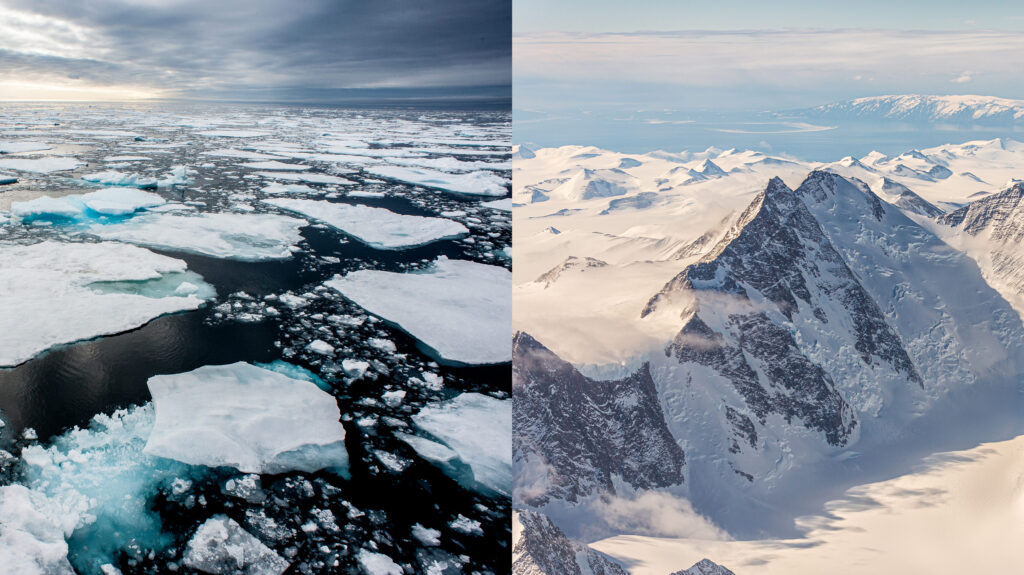
Arctic Ocean Vs Antarctica’s Mountains
- Antarctica was discovered later than the Arctic. European explorers first sighted Antarctica in January 1820. The Arctic was explored much earlier by Vikings in the 10th century. Svalbard, one of the most northern parts of the Arctic, was discovered in 1596, over 200 years before Antarctica.
- The wildlife species found are key to distinguishing between the Arctic and Antarctica. While it is possible to see some species in both places, such as Terns and Orcas, don’t expect to see polar bears in Antarctica or penguins in the Arctic.
- Antarctica has no permanent human or Indigenous population, just scientists, researchers, and visitors. The Arctic has an estimated population of 4 million people, with 400,000 indigenous people.
- Due to its warmer temperature, the Arctic has much more plant life than Antarctica. Antarctica, predominantly covered by ice, has no trees, shrubs, and just two flowering plants.
- Antarctica has the most enormous icebergs, with a staggering 4,250 sq miles surface area, holding the world record.

A giant iceberg in Antarctica
Arctic Region or Antarctica? – A Guide for Travellers
| Arctic | Antarctica | |
| When to visit | March – October | November – March |
| How to Get There | Expedition cruise or Flight | Expedition cruise or Charter Flight |
| Top Wildlife | Polar Bears, Walrus, Arctic foxes, Reindeer, Beluga Whales Orcas & Musk Ox | Penguins, Southern Elephant seals, leopard seals, wandering albatrosses |
| Can I See polar bears? | Yes, polar bears live throughout the Arctic | No, polar bears do not live in Antarctica |
| Can I see penguins? | No, penguins only live in the south | Yes, Antarctica and the Sub Antarctic has 8 species of penguins |
| Can I see Icebergs? | Yes, the largest ones are seen in Greenland | Yes, Antarctica’s icebergs are the largest on Earth. |
| Do People Live there? | The Arctic is inhabited with approximately 4 million people living above the Arctic Circle – 400,000 are indigenous | Antarctica has no indigenous population. It has a temporary population of seasonal staff working across 70 research stations. |
| Visitors Per Year (expedition cruises) | 78,848 | 75,000 (approximately) |
| Geography | Frozen ocean surrounded by land | Frozen land surrounded by ocean |
| Countries | Canada, Norway, Russia, USA, Iceland, Finland, Sweden and Greenland (Kingdom of Denmark) | Antarctica is a continent but not a country |
| Longest Day (Midnight Sun) | June 21 | December 21 |
| Shortest Day (Polar Night) | December 21 | June 21 |
| When Was It Discovered? | 1596 (Svalbard) | 1820 |
As you plan your trip, here are some differences between the Arctic and Antarctica for travellers:
- The Arctic is easier to reach than Antarctica. Longyearbyen in Svalbard has an airport that allows you to fly as far north as 78 degrees and join a cruise there.
- Trips to Antarctica are often longer and involve more time spent at sea. Many cruises to Antarctica take two days to sail across the Drake Passage to reach the 7th continent, adding four days on a return journey.
- In general, wildlife is more straightforward to spot in Antarctica. Penguin breeding colonies are easy to find. In the Arctic, polar bears and Arctic foxes are constantly roaming, so keeping a good lookout is essential.
- The North Geographic Pole can be reached on an icebreaker cruise, while the South Pole can only be reached on a specialist expedition involving flying.
- When travelling from Europe or North America, Antarctica is typically more expensive than the Arctic due to longer flights, greater distances and longer voyages.
Let’s take a deeper dive.
Arctic vs Antarctica | Seasons and when to visit
The good news is that it is possible to trip to the polar regions at any time of the year, as the Arctic and Antarctica have opposite seasons. The southern summer (known as the austral summer) runs from November until March, whilst the northern summer (boreal) runs from May until September.
Arctic
While it is possible to visit the Arctic all year round, the best time for expedition cruises and wildlife watching is during the northern summer between May and September. The Arctic tundra becomes alive, and animals return to the coast after a harsh winter.
For a detailed guide please see Best Time To Go To The Arctic.
Antarctica
Due to the extreme climate in the winter, it is only possible to visit Antarctica during the southern summer between late October and March. The Antarctic summer offers the best opportunities for wildlife as animals migrate to Antarctica for the summer months.
For a comprehensive overview please see Best Time To Visit Antarctica.
Animals: Polar Bears Or Penguins?
The wildlife of the Arctic and Antarctica has many distinctive species that can only be seen in the northern or southern polar regions, along with some common species found in both. A good place to start when choosing between the Arctic or Antarctica is what wildlife you would like to see.
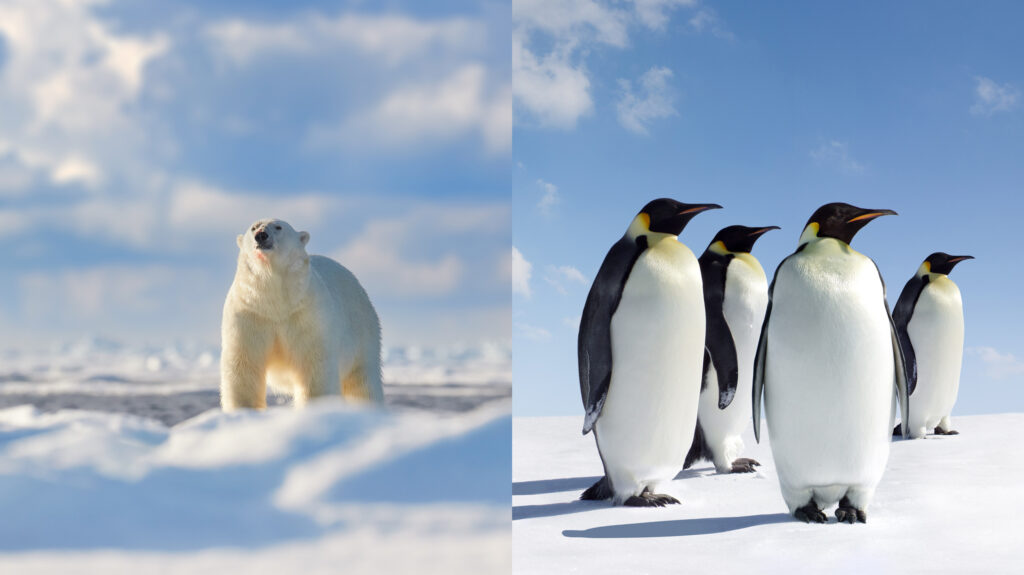
A polar bear in the Arctic and Emperor penguins in Antarctica
Arctic Species
Polar bears, walruses, arctic foxes, Arctic hares, Musk oxs, Beluga whales, reindeer, snowy owls, ringed seals, harp seals and narwhals are among the animals only seen in the Arctic region. For a full guide please see Arctic Animals.
Antarctica Species
Eight species of penguins (Adelie, chinstrap, emperor, king, Gentoo, rockhopper, and macaroni) live in Antarctica and the sub-antarctic. Leopard seals, fur seals, southern elephant seals, wandering albatrosses, and Antarctic Prions are found only in Antarctica. For a full guide please see Antarctica wildlife.
Common Species
Birds, including gulls, terns, and skuas, can be found in the Arctic and Antarctica. Common marine life includes 235 species, including orcas, blue whales, bearded seals, fin whales, marine snails, and krill.
The Arctic and Antarctic are natural paradises and wildlife watchers’ dreams. I first travelled to the Arctic and was taken aback by seeing polar bears and walruses in their natural habitat. It wasn’t long before I was going to Antarctica and South Georgia!
Top Tip: If wildlife viewing is one of your priorities, consider joining a small ship expedition cruise with an itinerary focused on animals. Several select departures focus on bird watching, whale watching, or polar bear viewing.
Which Is Colder, the Arctic or Antarctica?
Antarctica is significantly colder than the Arctic due to its large ice sheet, which acts like a giant refrigerator across the continent, cooling the air above it and reflecting heat from the sun’s rays into the atmosphere.
Antarctica is higher than the Arctic, and temperatures decrease the higher you get in altitude. The North Pole is at sea level on ice floes, whereas the South Pole is at 2835 meters on top of the Antarctic ice cap.
The currents of the Arctic Ocean and the Gulf Stream have a warming effect on the Arctic ice. In the High Arctic in west Svalbard, where the warming waters of the Gulfstream reach the coast, the sea does not freeze.
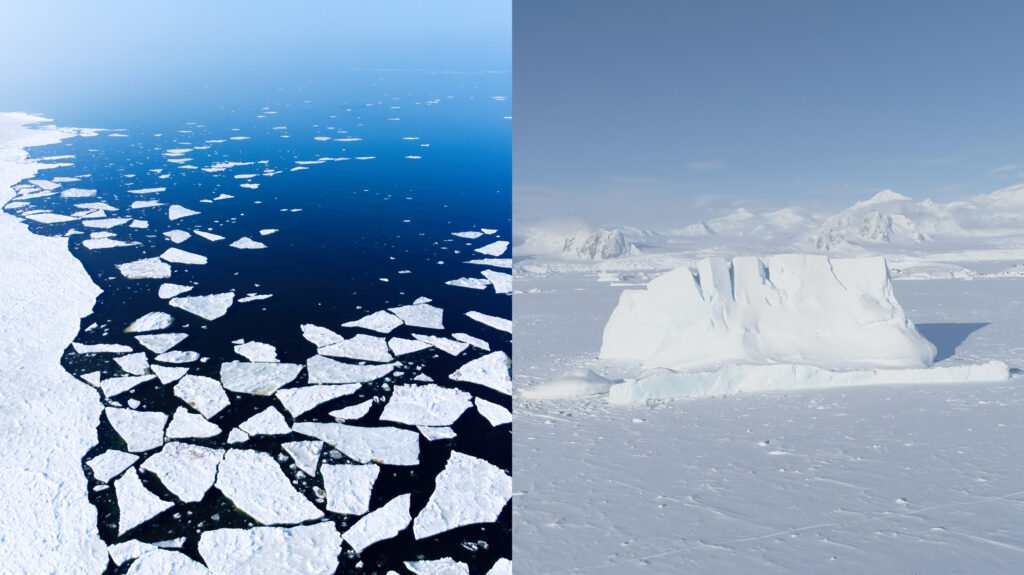
Arctic sea ice vs Antarctica sea ice
This is contrasted by the Antarctic Circumpolar Current in the Southern Ocean, which isolates Antarctica from any warm currents and contributes to making Antarctica colder than the Arctic. Antarctic sea ice often refreezes year after year.
Summer temperatures at the North and South Poles vary significantly. The average summer temperature at the South Pole is chilly -28°C, compared to the North Pole, which is around the freezing mark of 0°C in summer.
Top Tip: In my experience, travelling to Antarctica during the summer is significantly colder than the Arctic. Antarctica is often windier than the Arctic, and the wind, combined with low temperatures, can cause the windchill to drop low. As you plan your trip, it is worth considering taking extra layers and protection.
To find out more please see our guide How Cold Is Antarctica?
Geographical Differences Between The Arctic and Antarctica?
Continent Or Country?
One of the most common questions is whether Antarctica is a country or a continent.
Antarctica Is A Continent, and The Arctic Ocean Is A Region With 8 Countries
Antarctica is not a country as it has no human population, but it is a continent. It ranks as the world’s driest, windiest, coldest and southernmost continent and the only uninhabited continent.
Seven countries have territorial claims in Antarctica: Argentina, Australia, United Kingdom, New Zealand, Chile, France and Norway, but these claims are not accepted internationally.
The Antarctic Treaty governs Antarctica. It is an international agreement between 56 countries to protect the region and prevent military use of the continent.
The Arctic is not a continent because it predominantly comprises the Arctic Ocean. Eight countries are above the Arctic Circle: Greenland, Iceland, Canada, Norway, Sweden, Finland, Russia, and the USA.
The Arctic Council is a high-level intergovernmental forum between the Arctic states that cooperates and addresses issues related to the Arctic region.
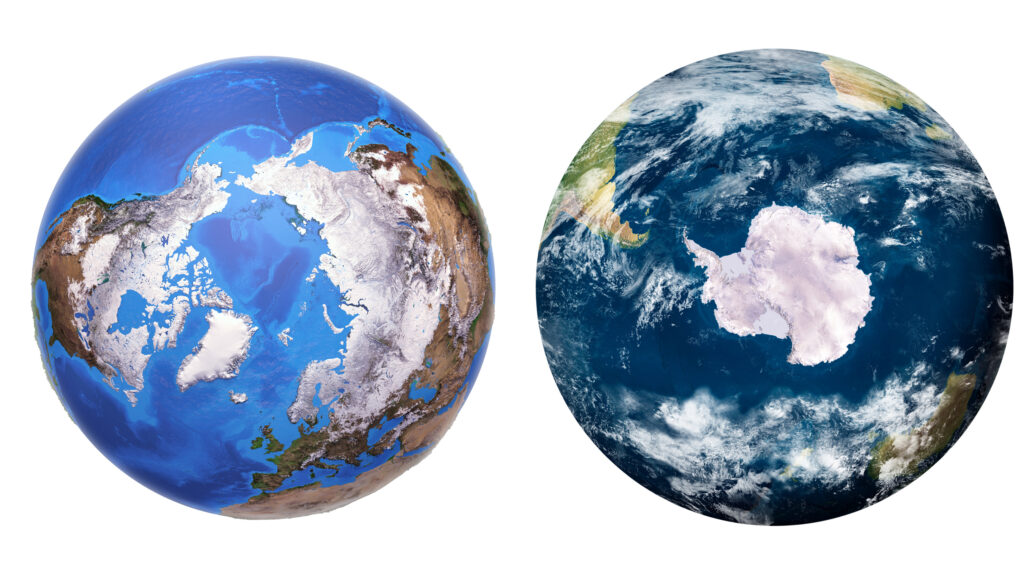
Aerial views of the Arctic vs Antarctica
Arctic Sea Ice or Landmass?
Antarctica is a Landmass Covered By Ice, and The Arctic is an ocean surrounded by land.
Antarctica is predominantly a low-lying land mass covered by a thick ice sheet covering 98% of the land. This explains the absence of wildlife in the harsh interior. According to the Australian Antarctic Program, the average thickness of the Antarctica ice sheet is 2.16km deep, with the thickest point 4,776m in Terre Adelie. The ice sheet contains 60% of the world’s freshwater. It would raise sea levels by up to 70 metres if it all melted.
The frozen Arctic Ocean predominately covers the Arctic. The sea ice melts during the summer and freezes during winter with seasonal sea ice. The Arctic Ocean is bordered by the coasts of Russia, Greenland, and northern Canada and countless islands and archipelagos such as Svalbard, Jan Mayen and Franz Josef land.
Human Population of Antarctica and The Arctic
A big difference between the Arctic and Antarctica is that Antarctica has no permanent human population.
The Arctic region is home to over 4 million people, including an estimated 400,000 indigenous people. I really enjoy visiting the Arctic because I learn about the Inuit and explore remote settlements to understand their way of life in the High Arctic. Some of the best trips offer activities with local hunters, such as dog sledging, for a fully immersive experience.
While Antarctica has no permanent human population, around 5,000 scientists, researchers, and station workers live there during summer. A highlight of a cruise to Antarctica is visiting a research station to learn about scientific work.
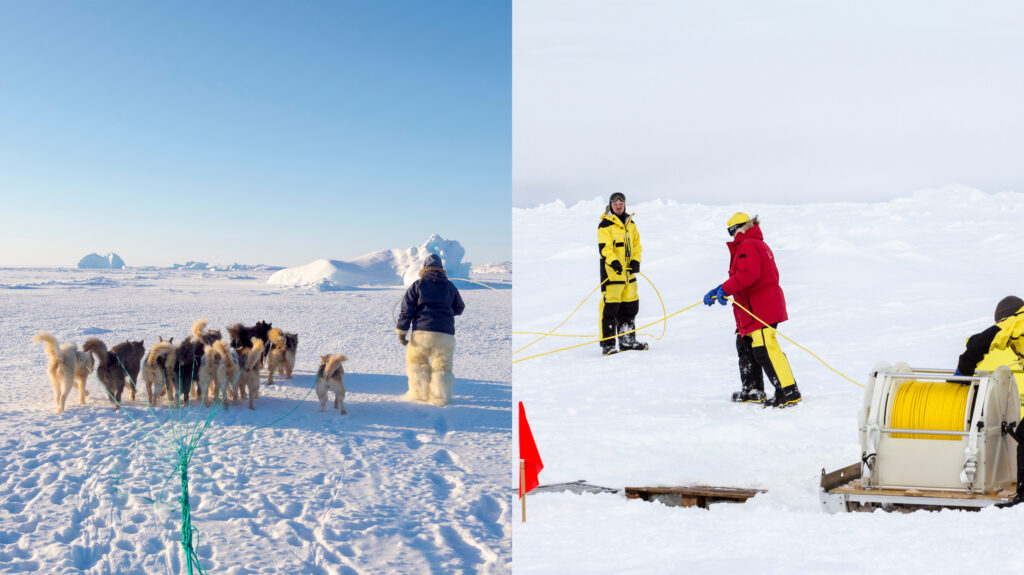
Inuit in the Arctic and researchers in Antarctica
History: Arctic Vs Antarctica
The First Discovery
For millennia, the Arctic has been inhabited by Inuit, known as the Thule people, who descended from Alaska. Vikings, led by Eric the Red, explored Greenland as far back as 985 A.C. The first European explorer to reach Svalbard in the High Arctic was William Barentz in 1596.
Due to its remoteness, Antarctica was discovered much later than the Arctic. Bellingshausen first sighted the continent on 28 January 1820. Although Captain Cook had made previous attempts to reach Antarctica in 1772, he never successfully sighted land.
The Race to The Poles
The South Pole was first reached by Roald Amundsen on 14th December 1911 by a team of men led by Norwegian explorer Roald Amundsen, who narrowly beat Robert Falcon Scott in the race to the South Pole.
To show you what a great polar explorer Amundsen was, he was also the first confirmed person to reach the Geographical North Pole on 12 May 1926, although there is some controversy about earlier attempts.
Similarities Between the Arctic and Antarctica
The Arctic and Antarctica are both polar regions and share many similarities.
- Both have sea ice, which occurs when the sea freezes during winter.
- Ice caps are present in the Arctic and Antarctica, forming impressive glaciers that meet the coastline.
- Large icebergs can be seen in both places where they break away from the calving faces of glaciers.
- Both the north and south extremes feature deserts and are some of the driest places on Earth.
- The Arctic and Antarctic feature some of the Earth’s most unspoilt and pristine landscapes.
- Both regions are home to numerous unique wildlife that keep travellers returning repeatedly.
- The Arctic and Antarctica are both vulnerable to climate change.
- Arctic and Antarctic travellers often return to see more.
The Arctic vs Antarctica: Our Verdict
As frequent travellers beyond the Arctic and Antarctic Circles, it is hard for us to say which we prefer. Both the Arctic and Antarctica offer fantastic wilderness, raw nature, wildlife, and places to explore. Each destination that we explore is unique in many ways, from the landscapes of East Greenland to the penguin colonies of South Georgia.
Choose the Arctic to see polar bears, walruses, and beluga whales in the wilderness and visit remote Inuit settlements in Arctic Canada and Greenland. This is also the best option for European travellers, as you can enjoy shorter trip lengths.
If you are happy to wrap up warm, choose Antarctica to experience the world’s most extreme continent, where you can encounter penguins, elephant seals, and some of the most remote places on Earth. The Antarctic summer is not as cold as you would think, with temperatures often above freezing.
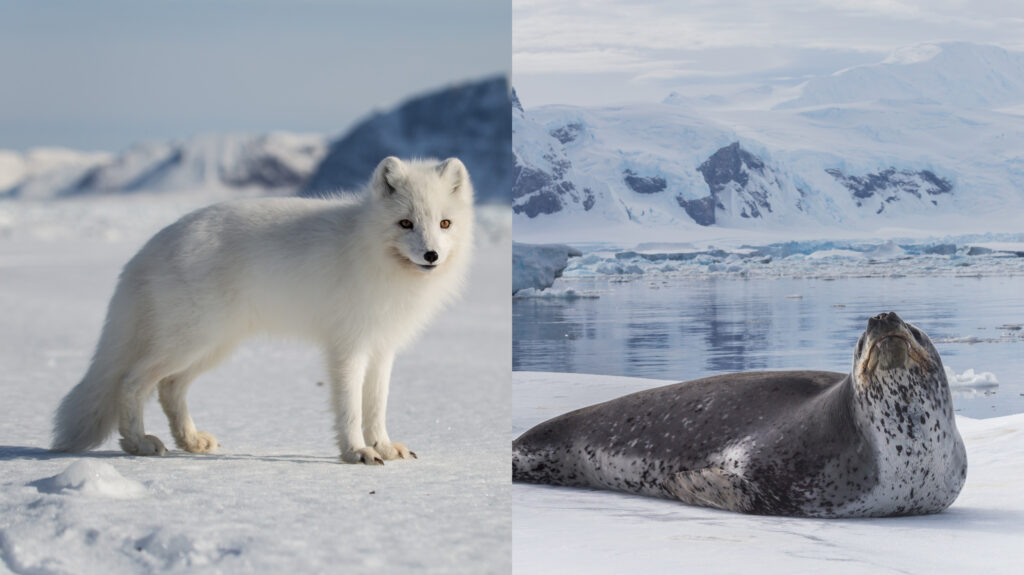
Arctic fox in Svalbard and a leopard seal in Antarctica
Top Tip: If you have not visited the polar regions before but are looking for a place to start, consider Svalbard. It was the first destination I visited and is described as the Arctic in a Nutshell, as you can encounter the best the Arctic offers in a relatively small area. It’s also excellent for polar bear sightings.
No matter where you choose to visit, you will undoubtedly be treated to some of the planet’s most awe-inspiring natural wonders.
Now that you know the differences between the Arctic and Antarctica, which places would you like to explore on a polar expedition?
At Polar Escapes, we are polar specialists with the largest selection of expedition cruises and tours to the polar regions. To find out more please see our Arctic and Antarctica Cruises.
You can also search all our cruises and tours, or why not get expert advice from our team at Polar Pros to help you plan your trip?
Thanks for reading, and happy exploring
Most emails are boring.
Ours are cool.




